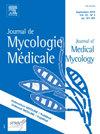耳念珠菌感染头部皮肤1例
IF 1.8
4区 医学
Q3 MYCOLOGY
引用次数: 0
摘要
背景耳念珠菌是一种新发现的酵母菌,于2009年在日本一名患者的耳分泌物中首次发现。它以其高死亡率、强传染性、能引起医院爆发和对多种药物具有耐药性而闻名,因此获得了“超级细菌”的绰号。目前,已确定的念珠菌有五个主要分支,包括南亚、东亚、南非、南美,以及在伊朗新发现的第五个分支。在六大洲的40多个国家记录了感染病例,引起了全球关注。2022年,世界卫生组织(世卫组织)在其首份真菌健康威胁清单中将耳念珠菌指定为最优先的病原体。由于缺乏标准化和有效的治疗方案和预防战略,导致许多治疗和控制失败。为了深入探讨耳念珠菌的临床管理策略和医院感染控制措施,我们对1例耳念珠菌感染病例进行回顾性分析,并简要复习相关文献。病例表现:54岁男性患者,病史复杂,并发耳念珠菌感染,表现为头皮溃疡性病变。医疗队实施局部伤口护理措施,包括碘伏消毒和红外线治疗,并严格遵守医院感染控制方案,成功控制了耳念珠菌感染,无院内传播。结论本病例研究强调了通过跨学科团队合作实施个性化治疗和量身定制的感染控制措施的重要性。成功的管理强调了遏制金黄色念珠菌传播的潜力,为今后针对这种新出现的多重耐药病原体的战略提供了有价值的见解。然而,在诊断、治疗和控制耳念珠菌感染方面的复杂挑战强调了加强研究和建立标准化方案的迫切需要。本文章由计算机程序翻译,如有差异,请以英文原文为准。
Head skin infection by Candida auris: A case report
Background
Candida auris is a recently discovered yeast species first found in 2009 in the ear discharge of a patient in Japan. Known for its high mortality rate, strong transmissibility, ability to cause hospital outbreaks, and resistance to multiple drugs, it has earned the nickname "superbug". Currently, there are five main clades of Candida auris identified, including the South Asian, East Asian, South African, South American, and a newly discovered fifth clade in Iran. Infection cases have been documented in over 40 countries across six continents, drawing global attention. In 2022, the World Health Organization (WHO) designated Candida auris as a top priority pathogen in their inaugural list of fungal threats to health. The lack of standardized and effective treatment protocols and prevention strategies has resulted in numerous treatment and control failures. To delve deeper into the clinical management strategies and hospital infection control measures for Candida auris, we conducted a retrospective analysis of a Candida auris infection case and briefly reviewed relevant literature.
Case presentation
A 54-year-old male patient with a complex medical history developed a Candida auris infection, presenting with ulcerative scalp lesions. The medical team implemented local wound care measures, including iodophor disinfection and infrared therapy, and strictly adhered to the hospital's infection control protocols, successfully controlling the Candida auris infection without any nosocomial transmission.
Conclusion
This case study highlights the importance of individualized treatment and tailored infection control measures implemented through interdisciplinary teamwork. The successful management underscores the potential for containing the spread of Candida auris, offering valuable insights for future strategies against this emerging multidrug-resistant pathogen. However, the complex challenges in diagnosing, treating, and controlling Candida auris infections emphasize the imperative need to enhance research and establish standardized protocols.
求助全文
通过发布文献求助,成功后即可免费获取论文全文。
去求助
来源期刊
CiteScore
5.10
自引率
2.80%
发文量
68
审稿时长
6-12 weeks
期刊介绍:
The Journal de Mycologie Medicale / Journal of Medical Mycology (JMM) publishes in English works dealing with human and animal mycology. The subjects treated are focused in particular on clinical, diagnostic, epidemiological, immunological, medical, pathological, preventive or therapeutic aspects of mycoses. Also covered are basic aspects linked primarily with morphology (electronic and photonic microscopy), physiology, biochemistry, cellular and molecular biology, immunochemistry, genetics, taxonomy or phylogeny of pathogenic or opportunistic fungi and actinomycetes in humans or animals. Studies of natural products showing inhibitory activity against pathogenic fungi cannot be considered without chemical characterization and identification of the compounds responsible for the inhibitory activity.
JMM publishes (guest) editorials, original articles, reviews (and minireviews), case reports, technical notes, letters to the editor and information. Only clinical cases with real originality (new species, new clinical present action, new geographical localization, etc.), and fully documented (identification methods, results, etc.), will be considered.
Under no circumstances does the journal guarantee publication before the editorial board makes its final decision.
The journal is indexed in the main international databases and is accessible worldwide through the ScienceDirect and ClinicalKey platforms.

 求助内容:
求助内容: 应助结果提醒方式:
应助结果提醒方式:


